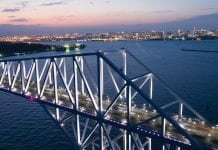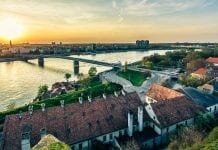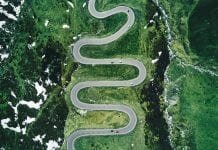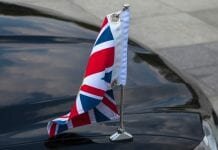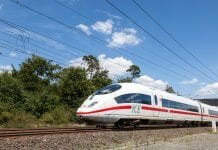
Smart lighting is an important aspect in developing the infrastructure of the future. Government Europa spoke to leading designer Daan Roosegaarde about his Smart Highway lighting project.
A project in the Netherlands is one of the first in the world to incorporate smart lighting into highways, attracting worldwide attention thanks to its innovative and creative thinking that uses clean and completely renewable energy to light up the road. Studio Roosegaarde’s Smart Highway lighting project has since expanded to incorporate a variety of new designs which will light up the cities of the future. The project’s glow-in-the-dark highways charge during the day and glow at night to create a sustainable lighting system; while buildings at the side of the road reflect the headlamps of cars, meaning energy is not wasted lighting the roads when no one is using them.
Inventor and designer Daan Roosegaarde has teamed up with the BMW Design Studio to work on electric mobility cars and is part of the team of scientists and designers at NASA who are working on benefits for humanity; as well as working with the European Space Agency on his Space Waste Project, upcycling space waste. Mr Roosegaarde spoke to Government Europa about the development of the Smart Highway lighting project, cityscapes of the future and how infrastructure needs to catch up with sustainable mobility.
How did the concept for your Smart Highway projects (Glowing Lines, Dynamic Paint, Gates of Light and other smart lighting projects) come about – what did you want to achieve?
The Smart Highways project incorporates a number of different initiatives to light up the roads from photo-luminising paint to reflective buildings; we crossed art and design with sustainable living and technology to envisage smarter infrastructure of the future – using cleaner energy and increasing efficiency for road users. Our projects look at the way city and landscapes are designed. We question why so much money, time, love and effort are put into the design and production of cars, but somehow roads seem to be disconnected from creative thinking. We ask if roads can be used as an interface for information, for energy harvesting, for expression, for iconic values. That’s when we started to come up with our first concepts: can we make roads that charge electrical cars? Can we make roads that charge in the day time and glow at night?
We were approached by the CEO of Heijmans, as he felt connected to the topic, and teamed up. We started to produce and build these ideas such as Glowing Lines. I think the reason our Van Gogh bicycle path got so much attention is because nobody was designing infrastructure in this way.
In the future cars will become smarter; and roads will have to catch up. The connectivity between cars, the landscape, roads and highways will become more important for safety, energy sustainability and user experience. We have now launched the Gates of Light project, which illuminates 60 buildings through retro-reflection using the headlamps of passing cars. This is a good example of an energy neutral landscape: there is no point having street lighting burning all night when there is nobody using it. This kind of lighting can keep going for many years; the rain keeps it clean and there are no cables and no maintenance necessary.
In June we are launching a long term collaboration with BMW. Adrian van Hooydonk, the head of design, is very interested in the connectivity between car and infrastructure. It’s always been an intrinsic relationship with the industry to push them to become more innovative. Infrastructure is a traditional business – there needs to be a balance between cars and the highway.
What technologies are harnessed to create these state-of-the-art projects and how does Studio Roosegaarde go about implementing them?
From state-of-the-art technology to implementing tried and tested methods found in nature, in order to innovate infrastructure, new designs need to harness creative thinking to provide practical solutions to clean living. Sometimes these projects use technologies we develop from scratch, sometimes we use principles inspired by nature – for example, The Gates of Light is inspired by the wings of a butterfly which reflect light. The colour of the butterfly wing always remains vivid – it is reflection on a microscopic level. These principles have been there for a long time, but we have implemented them in a new way.
Implementation involves a lot of research and development, a lot of prototypes and a lot of work to make it happen. Aside from the technological innovation it is also about the social innovation – how can a highway be good for society, given the inherent danger they pose? If you live next to a highway the long term effect on your health is similar to that of smoking around 16 cigarettes a day. We need to look at how we can transform that.
How does the Smart Highway lighting project benefit road users and contribute to emissions reduction or greener energy usage?
Our projects focus on improving quality of life for citizens and embracing ways of combining technology and infrastructure to improve usability and create more holistic spaces. Some aspects of Studio Roosegarde’s projects are about safety, while other aspects surround ideas of clean and low-cost energy – street lights which are energy neutral, for example, mean there is no energy bill. Other aspects are about creating an iconic experience. The Gates of Light is an iconic and important structure that a lot of people don’t know about, so we are literally highlighting its history – the famous blueprint of the architecture comes alive. I think it is a mix of practical and more poetic arguments that make these projects come alive; and safety in these projects is very important.
What is the potential for autonomous mobility in the future and its impact on design?
Studio Roosegaarde has teamed up with BMW to explore vehicle design of the future and our vehicles’ relationship to our roads. Thinking about how space can transform our experience as well as creating more symbiotic relationships with technology is key to innovating infrastructure and vehicle design.
We need to create a new space. In vehicles of the future we get our space and our time back, which is very interesting – these are new types of spaces in both a mental and physical way. The interior of a car can look different, so this liberates us to do other things. As technology takes over a lot of jobs, from the garbage collector to the accountant to driving, the essentially human skills – our desire to learn, our desire to create, our desire to explore – will become more important because this is something computers cannot do very well.
Technology is taking over some human jobs, but on the other hand it allows us to focus on the skills human beings can do very well; so maybe creativity is our true capital in that way. This is the way we should be going.
How can governments adopt and implement sustainable design, smart city and e-mobility solutions throughout Europe and what are the long-term benefits?
When designing a city or landscape you need to start with the values that people want. What I see regularly in meetings and lectures and in our worldwide projects is a demand for clean water, clean air and clean energy – to have a landscape which is good for people. If we start with these values, we then have to make decisions on how to design this landscape and infrastructure; and highways are a very important part of that. We have a right to have clean air and have a role in making it happen. In Paris the mayor is shutting down highways so people can walk on the street, cycling is becoming more popular – cities that do not invest in these ideas are going to have a tough ride.
What challenges are there to the implementation of smart city solutions?
There needs to be a vision and a plan. That may sound simple but a lot of the time it is not there. We need to look closely at the potential of roads and highways. The Van Gogh path for example is not just a path, it is also about tourism –as people can only see it at night they book hotel rooms nearby. We need to look at how roads can be good for tourism, good for health. We can expand the different sectors roads can have an impact on to get more awareness, more budget, and to get more people excited about it. It is a slow investment industry, but this is why we launched the Smart Highway lighting project – to show it can be done.
Will Studio Roosegarde be rolling out its projects across new grounds?
The Smart Highway lighting project is still growing and is being launched internationally. The BMW project is launching in June and we will be seeing a lot more of these smart projects being scaled up, as well as completely new designs like the Gates of Light but in different cities. There is a lot of attention in Canada, New York and the middle East – Dubai and places like China are very keen on these kinds of projects.
A smart city is all about connecting things – car, road, people and environment. Why don’t ant hills have traffic jams? Because they communicate, and they are very good at it. We are supposed to be smarter than that, so taking these examples and trying to set a new standard of life is one of my personal ambitions to improve this world. People need to start looking at how we can make these concepts grow – everyone agrees this is a big problem, but people still seem hesitant to push these projects forward.
Daan Roosegaarde
Studio Roosegaarde
+31 (0)103070909
Tweet @SRoosegaarde
www.studioroosegaarde.net


